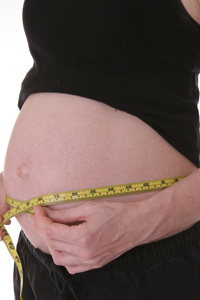
Twins, triplets, and other multiples
- How twins are formed
- Pregnancy with multiples
- More information on twins, triplets, and other multiples
If you are pregnant with more than one baby, you are far from alone. In the past two decades, the number of multiple births has climbed way up in the United States. In 2005, 133,122 twin babies and 6,208 triplet babies were born in the United States. In 1980 there were only 69,339 twin and 1,337 triplet births.
Why the increase? For one, more women are having babies after age 30. Women in their 30s are more likely than younger women to conceive more than one baby naturally. Another reason is that more women are using fertility treatments to help them conceive. Fertility treatments can increase the likelihood of multiple births.
How twins are formed
Twins form in one of two ways:

Identical twins occur when a single fertilized egg splits into two. Identical twins look almost exactly alike and share the exact same genes. Most identical twins happen by chance.

Fraternal twins occur when two, separate eggs are fertilized by two, separate sperm. Fraternal twins do not share the exact same genes — they are no more alike than they are to their siblings from different pregnancies. Fraternal twins tend to run in some families.
Multiple births can be fraternal, identical, or a combination. Multiples associated with fertility treatments are mainly fraternal.
Pregnancy with multiples
Years ago, most twins came as a surprise. Now, thanks to advances in prenatal care, most women learn about a multiple pregnancy early. You might suspect you are pregnant with multiples if you have more severe body changes, including:
- Rapid weight gain in the first trimester
- Intense nausea and vomiting
- Extreme breast tenderness
Your doctor can confirm whether you are carrying more than one baby through ultrasound. If you are pregnant with twins or other multiples, you will need to see your doctor more often than women who are carrying only one baby because your risk of complications is greater. Women carrying more than one baby are at higher risk of:
More frequent prenatal visits help your doctor to monitor your and your babies' health. Your doctor will also tell you how much weight to gain, if you need to take extra vitamins, and how much activity is safe. With close monitoring, your babies will have the best chance of being born near term and at a healthy weight.
After delivery and once your babies come home, you may feel overwhelmed and exhausted. Ask for help from your partner, family, and friends. Volunteer help and support groups for parents of multiples also can ease the transition.
More information on twins, triplets, and other multiples
Explore other publications and websites
-
Breastfeeding Multiples (Copyright © La Leche Leauge) — This publication provides a story of a woman who breastfed twins. This publication also gives tips on how to breastfeed multiple babies at the same time.
http://www.llli.org//NB/NBNovDec06p244.html
-
Breastfeeding Twins (Copyright © La Leche Leauge) — Before your babies arrive is a good time to learn as much as you can about breastfeeding. This publication gives information for breastfeeding twins.
http://www.llli.org//FAQ/twins.html
-
Multiples Birth (Copyright © American Pregnancy Association) — This site lists information related to multiple pregnancies, including prenatal care and complications.
http://www.americanpregnancy.org/multiples/
-
Multiples: Twins, Triplets and Beyond (Copyright © March of Dimes) — Some of the complications associated with multiple pregnancy can be minimized or prevented when they are diagnosed early. This publication provides steps a pregnant woman and her health care provider can take to help improve the chances that her babies will be born healthy.
http://www.marchofdimes.com/professionals/14332_4545.asp
-
Parenting Multiples (Copyright © Nemours Foundation) — The arrival of multiple newborns presents certain medical, logistical, financial, and emotional challenges for a family. But the increase of women having twins, triplets, quadruplets, and more also means an increase in resources to help those families. This publication explains how to deal with raising multiple newborns all at once.
http://kidshealth.org/parent/pregnancy/preparing/parenting_multiples.html
-
Surviving Bed Rest (Copyright © Nemours Foundation) — This publication describes plenty of ways to make your time in bed more enjoyable and productive and find out how to make the best of bed rest.
http://kidshealth.org/parent/pregnancy_newborn/pregnancy/bed_rest.html
-
Twin Pregnancy: What Multiples Mean for Mom (Copyright © Mayo Foundation for Medical Education and Research) — Many women are delaying pregnancy well into their 30s and beyond — when age-related hormonal changes may cause more than one egg to be released at a time. This boosts the odds of conceiving nonidentical (fraternal) twins. This publication explains what having twins can mean for the mother.
http://www.mayoclinic.com/print/twin-pregnancy/PR00120/METHOD=print
Connect with other organizations
-
American Academy of Family Physicians
http://familydoctor.org/online/famdocen/home.html
-
American College of Obstetricians and Gynecologists
http://www.acog.org/
-
American Pregnancy Association
http://www.americanpregnancy.org/
-
KidsHealth
http://kidshealth.org/
-
La Leche League International
http://www.llli.org/
-
March of Dimes
http://www.marchofdimes.com
-
National Organization of Mothers of Twins Clubs, Inc.
http://www.nomotc.org
-
Public Information and Communications Branch, NICHD, NIH, HHS
http://www.nichd.nih.gov
Content last updated September 27, 2010.
Resources last updated September 27, 2010.
womenshealth.gov
A federal government website managed by the Office on Women's Health in the Office of the Assistant Secretary for Health at the U.S. Department of Health and Human Services.
200 Independence Avenue, S.W. • Washington, DC 20201


 Text size
Text size Email
Email
